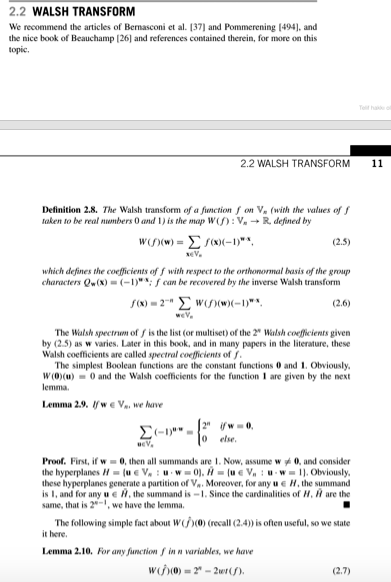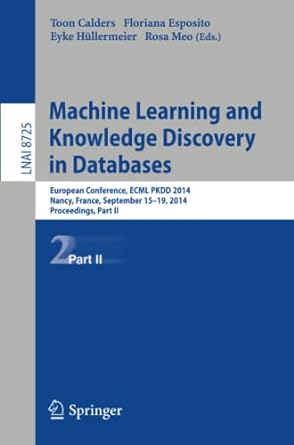Answered step by step
Verified Expert Solution
Question
1 Approved Answer
Hi I want to do these transformations but I couldn't. Can you tell the codes in cpp or c language? 1) Walsh transform 2) Fast
Hi I want to do these transformations but I couldn't. Can you tell the codes in cpp or c language?
1) Walsh transform

2) Fast Walsh transform

2.2 WALSH TRANSFORM We recommend the articles of Bernasconi et al. [37] and Pommerening [494), and the nice book of Beauchamp [26] and references contained therein, for more on this topic. Telt ha o 2.2 WALSH TRANSFORM 11 Definition 2.8. The Walsh transform of a function f on V. (with the values of f taken to be real numbers 0 and 1) is the map W(f): V. + R. defined by wS(W) = E S(x)(-1)"*. (2.5) which defines the coefficients of f with respect to the orthonormal basis of the group characters Qw(x) = (-1)": f can be recovered by the inverse Walsh transform (2.6) wev. The Walsh spectrum of f is the list (or multiset) of the 2" Walsh coefficients given by (2.5) as w varies. Later in this book, and in many papers in the literature, these Walsh coefficients are called spectral coeficients of f. The simplest Boolean functions are the constant functions 0 and 1. Obviously. W (0)(u) 0 and the Walsh coefficients for the function I are given by the next lemma. e Va, we have Lemma 2.9. If w 2 ifw0. " ucv. else. Proof. First, if w = 0, then all summands are 1. Now, assume w y 0, and consider the hyperplanes H = (u e V, : uw= 0). H = (ue V. :u-w= 1). Obviously. these hyperplanes generate a partition of Va. Moreover, for any u e H, the summand is I, and for any u e H, the summand is -1. Since the cardinalities of H, A are the same, that is 2-, we have the lemma. The following simple fact about W()(0) (recall (2.4) is often useful, so we state it here. Lemma 2.10. For any function f in n variables, we have w0) = 2 - 2wr(f). (2.7) 2.10 FAST WALSH TRANSFORM The computation of the Walsh transform would require about 22 operations (addi- tions, subtractions). There is a faster way to obtain the Walsh coefficients by using the Fast Walsh transform, which is a discrete version of the Fast Fourier transform. McWilliams and Sloane [392, Theorem 5. p. 422] give a description of the Fast Walsh transform. Theorem 2.32. The Sylvester-Hadamard matrix H, can be decomposed as H, = M" MC ... M). where M = I-i H1 ly-1, and Im is the m x m identity matrix. Tel hae olan 2.11 LFSRS AND LINEAR COMPLEXITY 23 Proof. By induction on n (see [392, p. 422|]). I -1 0 Eample 2.33. Mf : M -1 Remark 2.34. It is interesting to note that the matrices M other, that is, M M = M'M, for any i, j. commute with each The sparse matrix method of Theorem 2.32 enables one to compute the Walsh coefficients of the sign function f using only n2" operations [392]. There is another recent different approach for the computation of the Walsh trans- form of a Boolean function f on V, (see the work of Gupta and Sarkar [296]), where the authors use the ANF of f to speed up the computation of the Walsh transforrm at a set of points. However, for their algorithm to be feasible, it seems that it is neces- sary for f to be a sparse polynomial and its support 2, must contain vectors whose weight is "nearly" n. 2.2 WALSH TRANSFORM We recommend the articles of Bernasconi et al. [37] and Pommerening [494), and the nice book of Beauchamp [26] and references contained therein, for more on this topic. Telt ha o 2.2 WALSH TRANSFORM 11 Definition 2.8. The Walsh transform of a function f on V. (with the values of f taken to be real numbers 0 and 1) is the map W(f): V. + R. defined by wS(W) = E S(x)(-1)"*. (2.5) which defines the coefficients of f with respect to the orthonormal basis of the group characters Qw(x) = (-1)": f can be recovered by the inverse Walsh transform (2.6) wev. The Walsh spectrum of f is the list (or multiset) of the 2" Walsh coefficients given by (2.5) as w varies. Later in this book, and in many papers in the literature, these Walsh coefficients are called spectral coeficients of f. The simplest Boolean functions are the constant functions 0 and 1. Obviously. W (0)(u) 0 and the Walsh coefficients for the function I are given by the next lemma. e Va, we have Lemma 2.9. If w 2 ifw0. " ucv. else. Proof. First, if w = 0, then all summands are 1. Now, assume w y 0, and consider the hyperplanes H = (u e V, : uw= 0). H = (ue V. :u-w= 1). Obviously. these hyperplanes generate a partition of Va. Moreover, for any u e H, the summand is I, and for any u e H, the summand is -1. Since the cardinalities of H, A are the same, that is 2-, we have the lemma. The following simple fact about W()(0) (recall (2.4) is often useful, so we state it here. Lemma 2.10. For any function f in n variables, we have w0) = 2 - 2wr(f). (2.7) 2.10 FAST WALSH TRANSFORM The computation of the Walsh transform would require about 22 operations (addi- tions, subtractions). There is a faster way to obtain the Walsh coefficients by using the Fast Walsh transform, which is a discrete version of the Fast Fourier transform. McWilliams and Sloane [392, Theorem 5. p. 422] give a description of the Fast Walsh transform. Theorem 2.32. The Sylvester-Hadamard matrix H, can be decomposed as H, = M" MC ... M). where M = I-i H1 ly-1, and Im is the m x m identity matrix. Tel hae olan 2.11 LFSRS AND LINEAR COMPLEXITY 23 Proof. By induction on n (see [392, p. 422|]). I -1 0 Eample 2.33. Mf : M -1 Remark 2.34. It is interesting to note that the matrices M other, that is, M M = M'M, for any i, j. commute with each The sparse matrix method of Theorem 2.32 enables one to compute the Walsh coefficients of the sign function f using only n2" operations [392]. There is another recent different approach for the computation of the Walsh trans- form of a Boolean function f on V, (see the work of Gupta and Sarkar [296]), where the authors use the ANF of f to speed up the computation of the Walsh transforrm at a set of points. However, for their algorithm to be feasible, it seems that it is neces- sary for f to be a sparse polynomial and its support 2, must contain vectors whose weight is "nearly" n
Step by Step Solution
There are 3 Steps involved in it
Step: 1

Get Instant Access to Expert-Tailored Solutions
See step-by-step solutions with expert insights and AI powered tools for academic success
Step: 2

Step: 3

Ace Your Homework with AI
Get the answers you need in no time with our AI-driven, step-by-step assistance
Get Started


